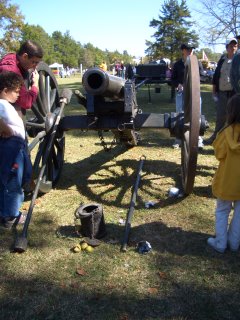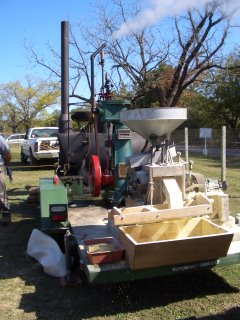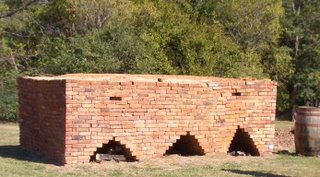Ames Plantation Day
I decided this morning that I would go to the Ames Plantation Festival today. It was an easy and scenic drive there. I had a map to get me to the plantation site and there were plenty of big signs marking the way. Parking was organized in a recently mowed hay field and school buses shuttled visitors from the parking area to the festival area. The shuttles ran a continuous loop, so there wasn't much waiting.
 There were lots of historical re-enactors present. Soldiers from the Union and Confederate Armies, complete with camps and cannon. One of the cannon was cast in 1864 at the Revere foundry in Boston for the Union Army, but was captured. The officer with the cannon says they can get 1600 yards out of her using ball, but mostly keep her to 300 yards. He also commented that at the maximum distance, you really need a forward observer to get targeting down. When firing ball, the cannon, being made of bronze, rings like a bell too. There are dents along the sides of the barrel where they think bullets struck the barrel when opposing forces were attempting to kill the cannon crew. There was a second cannon, cast of iron for the Mexican-American War, but also used in the Civil War. This particular group of Civil War re-enactors and their cannon have been in a number of movies, including Gettysburg and Gods and Generals.
There were lots of historical re-enactors present. Soldiers from the Union and Confederate Armies, complete with camps and cannon. One of the cannon was cast in 1864 at the Revere foundry in Boston for the Union Army, but was captured. The officer with the cannon says they can get 1600 yards out of her using ball, but mostly keep her to 300 yards. He also commented that at the maximum distance, you really need a forward observer to get targeting down. When firing ball, the cannon, being made of bronze, rings like a bell too. There are dents along the sides of the barrel where they think bullets struck the barrel when opposing forces were attempting to kill the cannon crew. There was a second cannon, cast of iron for the Mexican-American War, but also used in the Civil War. This particular group of Civil War re-enactors and their cannon have been in a number of movies, including Gettysburg and Gods and Generals.
 I watched spinners, a bobbin lace maker, a shuttle lace maker, a weaver, a dulcimer maker, a farrier (and a very handsome black draft horse who was watching everything around him with great interest), a chair caner, a basketmaker, several musicians, brick makers and some fellas with steam engines.
I watched spinners, a bobbin lace maker, a shuttle lace maker, a weaver, a dulcimer maker, a farrier (and a very handsome black draft horse who was watching everything around him with great interest), a chair caner, a basketmaker, several musicians, brick makers and some fellas with steam engines.
One steam engine was being used to grind cornmeal, one was pumping water (and could pump over 2100 gallons a day) and a third was being used to make ice cream for sale. The sound of a running steam engine is very distinctive. It reminds me a bit of the sounds that Mr. Mitty made in "The Secret Life of Walter Mitty" (ta-pocket-a pocket-a). They don't sound like they run very hard, compared to internal combustion engines, but they do a lot of work.
I learned that the Ames Plantation is actually multiple plantations which were obtained by Mr. Ames. It is now 35 square miles. The plantation belongs to the UT Ag Experiment Station. The National Field Trial Championships (for bird dogs) take place in early February. I bet that's something to see. There was a dog in the 2006 trials named Chispa's Rampage. I'm willing to bet that it's no relation whatsoever to the dog named Chispa that lived next door when I was in kindergarten. That Chispa was a gray toy poodle and was blamed for *everything* that went wrong or got broken when my sister and I were growing up.
 The plantation folks have built a brick kiln near the site of the plantation's original kiln and clay pit. Two men were demonstrating (with the help of some boy scouts) how bricks were made by hand. I did not realize that bricks were fired. I thought they were formed then air dried. It is true that they air dry, but are still very fragile as "green bricks" and cannot tolerate getting wet. Once a sufficiently large number of bricks is produced a kiln is built of the green bricks. Fires are built in the openings at the bottom and a low level of heat is used to cook the water out of the bricks. When the steam stops, the fire is built up hotter to cook the bricks completely. If you heat a green brick to the high temperature without cooking off the excess water first, the bricks tend to explode when the vaporized water escapes suddenly. A brick that got too hot tends to crack, so cannot be used on an exterior surface. Bricks which are not cooked enough are light in weight, but tend to be less sturdy and somewhat porous. I'd never given brick making much thought. I can see why brick houses and buildings were so expensive and so rare prior to mechanized brick production.
The plantation folks have built a brick kiln near the site of the plantation's original kiln and clay pit. Two men were demonstrating (with the help of some boy scouts) how bricks were made by hand. I did not realize that bricks were fired. I thought they were formed then air dried. It is true that they air dry, but are still very fragile as "green bricks" and cannot tolerate getting wet. Once a sufficiently large number of bricks is produced a kiln is built of the green bricks. Fires are built in the openings at the bottom and a low level of heat is used to cook the water out of the bricks. When the steam stops, the fire is built up hotter to cook the bricks completely. If you heat a green brick to the high temperature without cooking off the excess water first, the bricks tend to explode when the vaporized water escapes suddenly. A brick that got too hot tends to crack, so cannot be used on an exterior surface. Bricks which are not cooked enough are light in weight, but tend to be less sturdy and somewhat porous. I'd never given brick making much thought. I can see why brick houses and buildings were so expensive and so rare prior to mechanized brick production.
A fellow festival goer recommended hiking at Fall Creek Falls State Park when we rode the shuttle back to the parking area. We had ridden the shuttle into the festival together too and I had noticed that he has the men's version of my hiking boots. When I commented on that, he mentioned Fall Creek Falls.
By the time I got home I was exhausted. I made the mistake of not taking some sandwiches with me, so I basically went six hours without significant food and I walked around for a couple of hours too. I'm spending the evening drooling on myself and watching TV. I was going to organize the office this evening, but I think I'd be better off waiting until tomorrow and just go to bed early tonight.
In the Heat of the Night
Mr. Poitier just put a nice wrist lock on the murder suspect in "In the Heat of the Night". I can see why the suspect decided that kneeling next to Mr. Poitier would be a good idea, based upon the angle of his arm and hand. I've seen a similar hold in aikido class, but of course I don't know the name of it. Standing up becomes pretty much impossible, but holding that lock is fairly effortless.
 There were lots of historical re-enactors present. Soldiers from the Union and Confederate Armies, complete with camps and cannon. One of the cannon was cast in 1864 at the Revere foundry in Boston for the Union Army, but was captured. The officer with the cannon says they can get 1600 yards out of her using ball, but mostly keep her to 300 yards. He also commented that at the maximum distance, you really need a forward observer to get targeting down. When firing ball, the cannon, being made of bronze, rings like a bell too. There are dents along the sides of the barrel where they think bullets struck the barrel when opposing forces were attempting to kill the cannon crew. There was a second cannon, cast of iron for the Mexican-American War, but also used in the Civil War. This particular group of Civil War re-enactors and their cannon have been in a number of movies, including Gettysburg and Gods and Generals.
There were lots of historical re-enactors present. Soldiers from the Union and Confederate Armies, complete with camps and cannon. One of the cannon was cast in 1864 at the Revere foundry in Boston for the Union Army, but was captured. The officer with the cannon says they can get 1600 yards out of her using ball, but mostly keep her to 300 yards. He also commented that at the maximum distance, you really need a forward observer to get targeting down. When firing ball, the cannon, being made of bronze, rings like a bell too. There are dents along the sides of the barrel where they think bullets struck the barrel when opposing forces were attempting to kill the cannon crew. There was a second cannon, cast of iron for the Mexican-American War, but also used in the Civil War. This particular group of Civil War re-enactors and their cannon have been in a number of movies, including Gettysburg and Gods and Generals. I watched spinners, a bobbin lace maker, a shuttle lace maker, a weaver, a dulcimer maker, a farrier (and a very handsome black draft horse who was watching everything around him with great interest), a chair caner, a basketmaker, several musicians, brick makers and some fellas with steam engines.
I watched spinners, a bobbin lace maker, a shuttle lace maker, a weaver, a dulcimer maker, a farrier (and a very handsome black draft horse who was watching everything around him with great interest), a chair caner, a basketmaker, several musicians, brick makers and some fellas with steam engines.
One steam engine was being used to grind cornmeal, one was pumping water (and could pump over 2100 gallons a day) and a third was being used to make ice cream for sale. The sound of a running steam engine is very distinctive. It reminds me a bit of the sounds that Mr. Mitty made in "The Secret Life of Walter Mitty" (ta-pocket-a pocket-a). They don't sound like they run very hard, compared to internal combustion engines, but they do a lot of work.
I learned that the Ames Plantation is actually multiple plantations which were obtained by Mr. Ames. It is now 35 square miles. The plantation belongs to the UT Ag Experiment Station. The National Field Trial Championships (for bird dogs) take place in early February. I bet that's something to see. There was a dog in the 2006 trials named Chispa's Rampage. I'm willing to bet that it's no relation whatsoever to the dog named Chispa that lived next door when I was in kindergarten. That Chispa was a gray toy poodle and was blamed for *everything* that went wrong or got broken when my sister and I were growing up.
 The plantation folks have built a brick kiln near the site of the plantation's original kiln and clay pit. Two men were demonstrating (with the help of some boy scouts) how bricks were made by hand. I did not realize that bricks were fired. I thought they were formed then air dried. It is true that they air dry, but are still very fragile as "green bricks" and cannot tolerate getting wet. Once a sufficiently large number of bricks is produced a kiln is built of the green bricks. Fires are built in the openings at the bottom and a low level of heat is used to cook the water out of the bricks. When the steam stops, the fire is built up hotter to cook the bricks completely. If you heat a green brick to the high temperature without cooking off the excess water first, the bricks tend to explode when the vaporized water escapes suddenly. A brick that got too hot tends to crack, so cannot be used on an exterior surface. Bricks which are not cooked enough are light in weight, but tend to be less sturdy and somewhat porous. I'd never given brick making much thought. I can see why brick houses and buildings were so expensive and so rare prior to mechanized brick production.
The plantation folks have built a brick kiln near the site of the plantation's original kiln and clay pit. Two men were demonstrating (with the help of some boy scouts) how bricks were made by hand. I did not realize that bricks were fired. I thought they were formed then air dried. It is true that they air dry, but are still very fragile as "green bricks" and cannot tolerate getting wet. Once a sufficiently large number of bricks is produced a kiln is built of the green bricks. Fires are built in the openings at the bottom and a low level of heat is used to cook the water out of the bricks. When the steam stops, the fire is built up hotter to cook the bricks completely. If you heat a green brick to the high temperature without cooking off the excess water first, the bricks tend to explode when the vaporized water escapes suddenly. A brick that got too hot tends to crack, so cannot be used on an exterior surface. Bricks which are not cooked enough are light in weight, but tend to be less sturdy and somewhat porous. I'd never given brick making much thought. I can see why brick houses and buildings were so expensive and so rare prior to mechanized brick production.A fellow festival goer recommended hiking at Fall Creek Falls State Park when we rode the shuttle back to the parking area. We had ridden the shuttle into the festival together too and I had noticed that he has the men's version of my hiking boots. When I commented on that, he mentioned Fall Creek Falls.
By the time I got home I was exhausted. I made the mistake of not taking some sandwiches with me, so I basically went six hours without significant food and I walked around for a couple of hours too. I'm spending the evening drooling on myself and watching TV. I was going to organize the office this evening, but I think I'd be better off waiting until tomorrow and just go to bed early tonight.
In the Heat of the Night
Mr. Poitier just put a nice wrist lock on the murder suspect in "In the Heat of the Night". I can see why the suspect decided that kneeling next to Mr. Poitier would be a good idea, based upon the angle of his arm and hand. I've seen a similar hold in aikido class, but of course I don't know the name of it. Standing up becomes pretty much impossible, but holding that lock is fairly effortless.

Comments